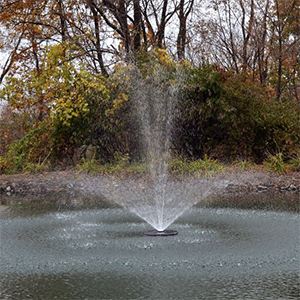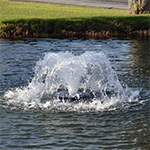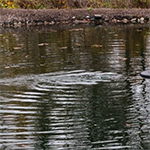Currently Empty: $0.00
If you are considering a fountain or aeration system please call or email us to inquire about a professionally installed system tailored to your specific needs.
If you are considering a fountain or aeration system please call or email us to inquire about a professionally installed system tailored to your specific needs.


As a general rule, floating fountains can be generally classified as either a fountain (high pressure, decorative spray pattern) or an aerating fountain (low pressure, heavy water spray pattern).
Either one can help the water body by addressing the following:
Everyone knows that water is made up of two parts hydrogen and one part oxygen. Unfortunately, the one part oxygen that makes up the water molecule is not available to add the extra oxygen to support and sustain aquatic life.
Just as plants on land add oxygen to the atmosphere, so do aquatic plants and algae add oxygen to the water. Wind that blows across the pond causing ripples also adds oxygen. When it rains, oxygen is also added.
In a typical storm water pond, unfortunately, these natural forms of aeration may not be enough to satisfy the narrow benchmark of a healthy pond.
As a comparison, our atmosphere is made up of about 20% oxygen. That is equal to about 200,000 parts per million of oxygen. Water, by contrast, has a very small band by which life either thrives or dies. A healthy pond normally measures at 3 PPM to 10 PPM. Below 3 PPM, life suffers or dies.
Because oxygen dissolves at very low concentrations in water, a healthy pond can quickly turn into a deadly pond in very short order. Outside influences such as temperature, stagnation, and abundant vegetation can create a situation where there is little to no oxygen to support life.
In effect, the lake or pond becomes a cess-pool. It begins to look like what you can imagine a cess-pool would look like, or even worse.
A properly sized and well-engineered aeration system can deter this negative scenario from developing.
One more great advantage to having an aerated lake/pond is that the aeration helps to keep the accumulated bottom organic sediment from building up and adding nutrients to fuel algal blooms, as well as filling the pond in, thereby prolonging the need to dredge the pond.
Aquatic Resource Management (ARM) proudly sells, installs, and services equipment from many brand name suppliers in the aquatic industry. ARM has the personnel that has been providing this quality service for over 30 years.
The relationship that ARM has with the Otterbine manufacturer of fountain and aeration equipment has been the benchmark for the success of our business. It is also understood that with so many fountain providers there may be times when a different spray pattern or type is desired. ARM has partnered with these suppliers to offer their full product line of equipment to satisfy the needs of these requests.
 Fountain
FountainMany suppliers build their equipment to generate high-pressure to allow them to create many decorative spray patterns. With “high” pressure, you get “low” water volume. All of this is accomplished through the impeller design, coupled to the nozzle or pump chamber.

Some suppliers offer equipment with impeller and pump chamber designed to operate at “low” pressure while pumping “high” volumes of water. Typically, these spray patterns are very basic in form, but the water flow is heavy.

This type of unit for a lake or pond is very similar to what you would find in a typical fish tank. A compressor motor creates compressed air and sends it through a tube to some type of diffuser sitting at the bottom of the tank. A lake or pond that employs this system will have many diffusers located strategically through the water body; each diffuser adding oxygen.